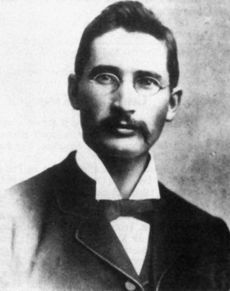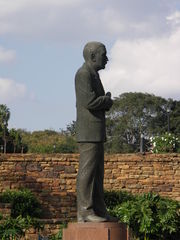J. B. M. Hertzog
| James Barry Munnik Hertzog | |
 |
|
|
3rd Prime Minister of South Africa
|
|
|---|---|
| In office 30 June 1924 – 5 September 1939 |
|
| Monarch | George V Edward VIII George VI |
| Governor–General | 1st Earl of Athlone 6th Earl of Clarendon |
| Preceded by | Jan Christiaan Smuts |
| Succeeded by | Jan Christiaan Smuts |
|
|
|
| Born | 3 April 1866 Wellington, Cape Colony |
| Died | 21 November 1942 (aged 76) Pretoria, Transvaal Province, Union of South Africa |
| Political party | National Party United Party |
| Religion | Dutch Reformed |

James Barry Munnik Hertzog, better known as J. B. M. Hertzog (3 April 1866 near Wellington, Cape Colony – 21 November 1942 in Pretoria, Union of South Africa) was a general on the Boer side during the second Anglo-Boer War and the Prime Minister of the Union of South Africa from 1924 to 1939. Throughout his life he encouraged the development of the Afrikaner culture, determined to protect the Afrikaner from British influence. He is named after Dr. James Barry who performed the first successful caesarean section in Africa by a British surgeon, in which both the mother and child survived the operation. In 2007 a building was built in Paarl and named after him to honor his legacy.[1]
Contents |
General Hertzog
Hertzog first studied law at Victoria College in Stellenbosch, Cape Colony. In 1889 he went to the Netherlands to read law at the University of Amsterdam, where he prepared a dissertation on the strength of which he received his doctorate in law on 12 November 1892.[2][3]
He had a law practice in Pretoria from 1892 until 1895, when he was appointed to the Orange Free State High Court. During the Boer War of 1899-1902 he rose to the rank of general, becoming the assistant chief commandant of the military forces of the Orange Free State. Despite some military reverses, he gained renown as a daring and resourceful leader of the guerilla forces continuing to fight the British. Eventually, convinced of the futility of further bloodshed, he signed the May 1902 Treaty of Vereeniging.
Politician
With the country now at peace, Hertzog plunged into politics as the chief organizer of the Orangia Unie Party. In 1907, the Orange River Colony gained self-government and Hertzog joined the cabinet as Attorney-General and Director of Education. His insistence that Dutch as well as English be taught in the schools met bitter opposition. He was appointed Minister of Justice in the new nation formed on 31 May 1910 called the Union of South Africa. He continued in office until 1912. His antagonism to imperialism and to Premier Botha led to a ministerial crisis. In 1913 he led a secession of the Old Boer and anti-imperialist section from the South African Party.
At the outbreak of the South African rebellion in 1914, he kept aloof, not opposing either side. In the years following the war, he headed the opposition to the government of General Smuts.
Prime minister
In the general election of 1924, his National Party defeated the South African Party of Jan Smuts and became the government. In 1934, the National Party and the South African Party merged to form the United Party.
Hertzog was a republican who believed strongly in promoting the independence of the Union of South Africa from the British Empire. His government approved the Statute of Westminster in 1931.
On 4 September 1939, the United Party caucus refused to accept Hertzog's stance of neutrality in World War II and deposed him in favor of Smuts.
References
- ↑ Die storie van James Barry Munnik at www.paarlpost.com
- ↑ Hertzog, J.B.M. (1892). De 'income'-bond, zijn rechtskarakter en de waarde zijner economische en juridische beginselen. Amsterdam: Universiteit van Amsterdam.
- ↑ Album academicum van het Athenaeum Illustre en van de Universiteit van Amsterdam. Amsterdam: R.W.P. de Vries. 1913. pp. 173.
External links
| Political offices | ||
|---|---|---|
| Preceded by Jan Smuts |
Prime Minister of South Africa 1924–1939 |
Succeeded by Jan Smuts |
| Party political offices | ||
| Preceded by party created |
Leader of the United Party 1934–1939 |
Succeeded by Jan Smuts |
|
|||||||||||
|
|||||||||||
